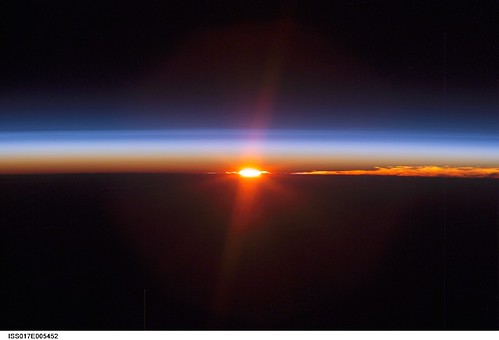Sunsets, Scattering, and Similes
- By Faith Tucker
- July 22, 2011
- 4 Comments
There are two sides to every coin. And there are (at least) two ways to describe any natural phenomenon. Take a sunset, for example. A physicist may describe a sunset as the electromagnetic radiation from the Sun undergoing Rayleigh scattering as it passes through the atmosphere low on the horizon, causing the shorter blue wavelengths of light to be scattered away while leaving the longer red wavelengths to reach the observer. However, a poet may just as soon describe the very same event as a poignantly emotional moment that arouses a sense of finality and subdued reflection as a chapter of life comes to a close. And then there’s also your mom for whom it is the non-negotiable end of your backyard safari (Why? Because she says so.), but I digress.

A lovely sunset as seen from the International Space Station, credit: NASA
This duality, or multiplicity as the case may be, of descriptions for a single phenomenon is an example of what British scientist and novelist CP Snow once described in his book entitled “The Two Cultures.” In his experience, modern society seemed hopelessly split into two camps -the humanities and the sciences. Each ‘culture’ had its own distinct interpretation of the world around them, but neither had even the most basic content knowledge of the other discipline. Conflict ensued. With one foot in each camp, Snow gives the following personal example:
“A good many times I have been present at gatherings of people who, by the standards of the traditional culture, are thought highly educated and who have with considerable gusto been expressing their incredulity at the illiteracy of scientists. Once or twice I have been provoked and have asked the company how many of them could describe the Second Law of Thermodynamics. The response was cold: it was also negative. Yet I was asking something which is the scientific equivalent of: Have you read a work of Shakespeare’s?”
To Snow writing in England during the 1950s and 1960s, the division was a major obstacle in overcoming many problems facing the world (though he later felt his judgment was a little too harsh). Since that time the ever-flowing river of technological and scientific advancements has only broadened the expanse separating the banks of the scientific community from that of those for whom iambic pentameter may come more naturally than differential equations. More than ever, there is a need today for people who can bridge this divide, clearly communicating the science that is shaping society and its relevance to those outside of the scientific community.
Enter the science writer. This unique brand of writer takes the often impenetrable language of science and interprets it for the general public, alerting them to important discoveries and developments in an understandable and accessible manner. According to Francis Reddy, the Senior Science Writer for the Astrophysics Science Division here at Goddard, “every blog post, web story, broadcast segment, press release or printed article that explains a scientific or technical finding to non-specialists is an example of science writing.” A successful science writer, therefore, must not only have a thorough scientific background, but they also must be skilled communicators, world-class nutshellers, and masters of metaphor – a tall order to say the least!
Why is communicating with the public particularly important for NASA? “At the most practical level,” says Reddy, “taxpayers fund NASA researchers and their activities, and they should receive some idea of what’s happening with their money.” However, beyond and more important than fiscal transparency is the fact that we are surrounded by a fascinating and amazing universe literally extending in all directions that is open and waiting to be explored by us all. That exploration may take the form of rigorous work designing instruments and analyzing data for a few, but, Reddy explains, “for the rest of us, exploration happens through a moment of reflection about those discoveries and appreciation of what it means to understand another piece of the large universe.” In the words of vlogger Hank Green, NASA is using your tax dollars to “increase the awesome” and so it only makes sense that we let you know all of the incredible ways we’re doing this and invite you to participate in this thrilling work!
We’ve linked to this before, but in case you haven’t seen it, check out Hank Green’s “Increasing the Awesome” video:
In addition to communicating the science itself, science writing also endeavors to convey why this information is relevant to the public and to society as a whole. “What NASA discovers is for everyone,” Reddy says, “so it’s important to reach out beyond the technical audience to the public at large.” In a world without science writers, non-scientists would have fewer opportunities to learn about new discoveries and technological advances and how they may affect day-to-day life. For example, while preparing for a future missions to Mars NASA developed an innovative, clean and sustainable energy source, which has recently been adapted for commercial use and is now supplying clean, eco-friendly energy to such Fortune-500 companies as Google, eBay, Bank of America, The Coca-Cola Company, and FedEx. Who knew Martian technology was so applicable!
Sunsets have many different but complementary understandings, each viewpoint lending depth and insight to the others. This multiplicity of perspectives is true of the whole physical universe and is why it’s important to facilitate communication between these two or more ‘cultures.’ Snow felt that the gap in understanding between the scientific and non-scientific communities was an impediment to solving the many problems facing the world. Could this be true today? A bridge is needed to connect these two increasingly separate bodies of knowledge, and science writers, among other professionals, work to straddle this divide for the benefit of both communities.




this is great.
Another great post. Those of us who can, must help bridge the gap between scientific and non-scientific “cultures.” Thank you for the inspiration.
Beautiful.
Awesome! The sunset without light poisoning…